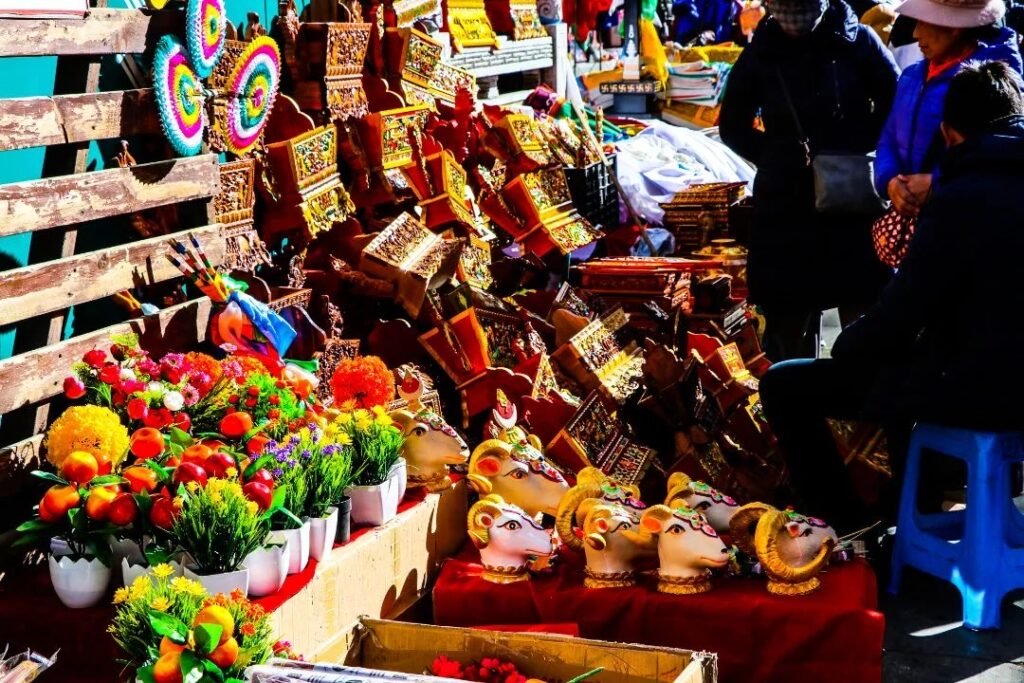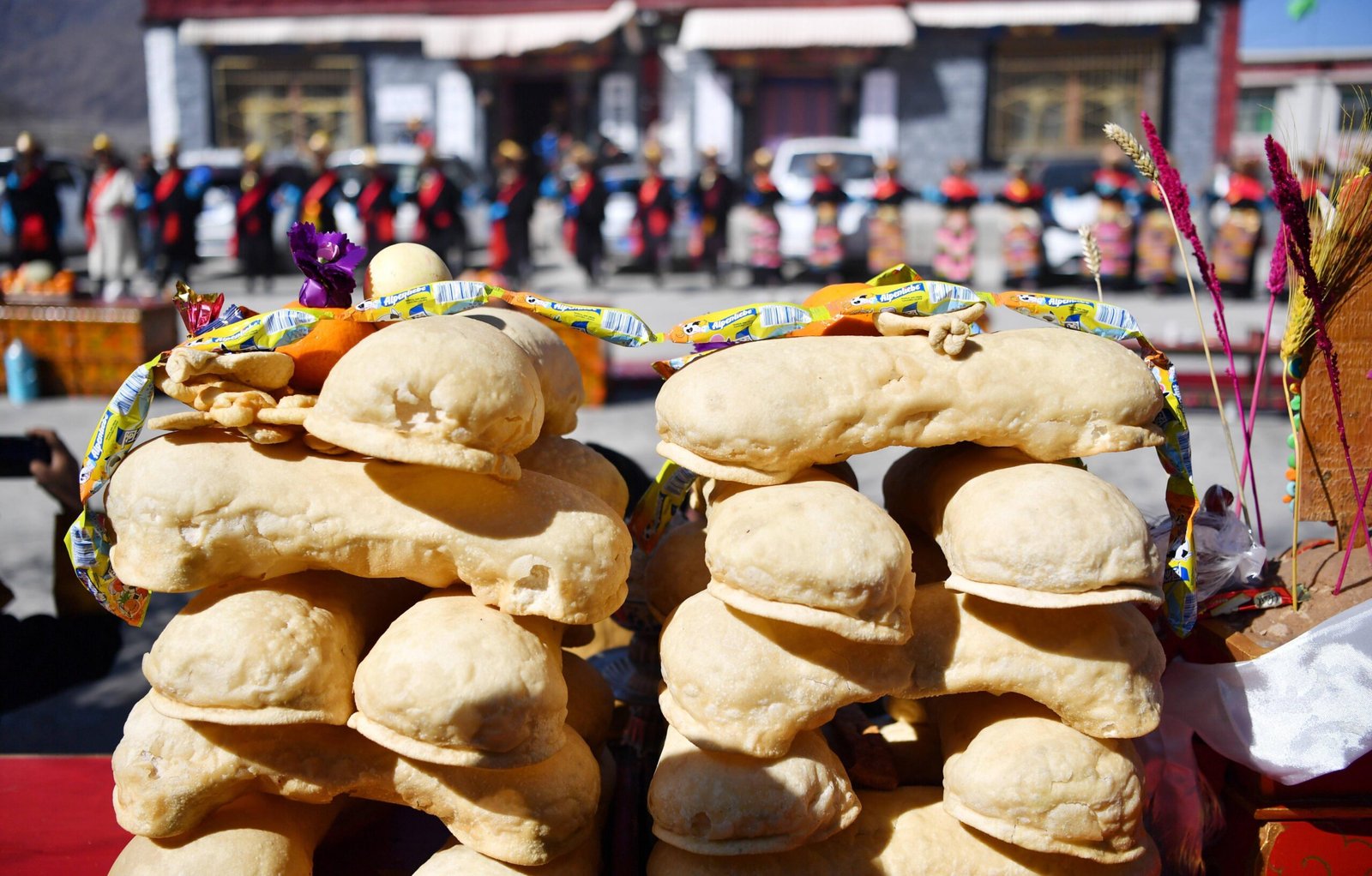Losar, the Tibetan New Year, holds a special place in the hearts of Tibetans. Celebrated on the first day of the first month in the Tibetan lunisolar calendar. Losar, known as “Gyalpo Lo-Sar,” is steeped in history and rich traditions.
A Glimpse into Tibetan Calendar’s History
The origins of the Tibetan calendar trace back to over a millennium before the Common Era, when the Tibetan people developed their own system of timekeeping based on lunar phases. This calendar has evolved significantly over the centuries. The followers of the Yungdrung Bön religion, one of Tibet’s ancient spiritual traditions, refined this system, basing the year’s start on the winter solstice. This calculation led to the establishment of various festivals and ceremonial practices. Many modern Tibetan customs and lifestyles are inherited from this ancient period, known as the time of Zhang Zhung.

Evolution of the Calendar: The Influence from Foreign country
The 7th century marked a significant period in Tibetan history with the Tubo dynasty. The marriages of Princess Wencheng and Princess Bhrikuti from the Tang dynasty to Tibetan kings introduced the foreign calendar to Tibet. Starting in 1027, the Kalachakra (‘Wheel of Time’) calendar, drawn from the astronomical knowledge in the “Kalachakra Tantra,” began its widespread use in Tibet.
Festivities Leading Up to Losar
Tibet’s festive mode kicks off in the tenth month of the Tibetan calendar. The celebrations begin with the Kongpo New Year in the Nyingchi region (including Bayi District, Milin County, and Gongbo’gyamda County), followed by the Pülan New Year in Ngari, and then the Shigatse New Year. These lead up to the Gregorian New Year and the Spring Festival, culminating in the grand celebration of the Tibetan New Year.
Immersive Celebrations of the Tibetan New Year
Losar is the most significant and grandiose festival for Tibetans. Let’s delve into how this auspicious occasion is celebrated:
- Preparation and Purification: In the days leading up to Losar, Tibetans engage in a thorough cleaning of their homes and surroundings, symbolizing the sweeping away of any misfortunes and making way for incoming blessings.
- Religious Observances: Monasteries hold special rituals. Families visit local temples to offer prayers and seek blessings for the new year.
- Cultural Festivities: The air is filled with the sounds of music, dancing, and singing. Traditional performances and community gatherings are commonplace.
- Family and Feasting: Families gather to enjoy traditional foods such as “guthuk” (a special noodle soup) and “khapse” (Tibetan pastries). The exchange of gifts and visits among relatives and friends strengthens community bonds.
- Losar Decorations: Homes are adorned with colorful decorations, and prayer flags flutter in the wind, carrying good wishes and prayers to the heavens.
Losar is not just a new year celebration; it’s a vibrant expression of Tibetan culture, spirituality, and community spirit, reflecting the rich heritage and resilience of the Tibetan people.
Preparing for Losar: Tibetan New Year Traditions
Stocking Up on New Year Goods
In anticipation of Losar, the Tibetan New Year, preparations begin in earnest from the start of the 12th month of the Tibetan calendar. Households engage in the ritual of soaking barley seeds in water basins to sprout green seedlings, symbolizing hopes for a bountiful harvest in the coming year.
The Art of Making Kasai
One of the essential foods for Losar is Kasai, a deep-fried delicacy made from butter and flour. These treats come in various shapes such as “Gu-Guo” (ear-shaped), “Na-Xia” (long-shaped), and “Bu-Lu” (round-shaped). Adorned with colorful paints and coated with sugar, Kasai serves both as an artistic creation and a delightful treat for guests.
Gutu: The Tibetan New Year’s Eve Dinner
On the eve of the Tibetan New Year, families prepare a special dish called Gutu. The word “Gu” means nine, a lucky number in Tibetan culture, and “Tu” refers to a thick soup. Gutu contains nine auspicious ingredients, including lamb, Tsampa (barley flour), wheat grains, almonds, cheese residues, and radishes, all cooked together into a dough-ball soup.
Each dough ball in Gutu may contain a hidden item, each with its own symbolic meaning. Finding “wool” signifies a kind heart, “chili” indicates assertiveness, “charcoal” suggests a dark heart, and “stone” implies a hard heart. Discovering a coin predicts wealth. The family enjoys guessing the meanings as they eat, adding fun and laughter to the New Year’s celebrations.
The Ghost-Exorcising Ritual
After the Gutu feast, a significant ritual takes place to expel evil spirits. This involves a person running with a plate of ghost food, followed by others with torches. The ceremony culminates with the smashing of the plate into a burning pile of barley straw, symbolizing the elimination of bad luck and welcoming good fortune for the New Year.
Losar Eve: Tibetan Traditions of Renewal and Good Fortune
The Ritual of Cleansing and Renewal
As the Tibetan New Year draws closer, the 30th day of the last month in the Tibetan calendar is dedicated to cleansing and renewing homes to welcome the new year. Families engage in thorough cleaning and redecorating to bid farewell to the old year and greet the new with a fresh start.
The Eight Auspicious Symbols
A key tradition involves painting the “Eight Auspicious Symbols” on the central wall of the kitchen, a place of great importance in Tibetan culture. These symbols are deeply embedded in Buddhist iconography and include:
- The Endless Knot: Symbolize the interconnectedness of all things.
- The Golden Wheel: Representing the teachings of Buddha.
- The Lotus Flower: Denoting purity and spiritual awakening.
- The Precious Umbrella: Signifying protection and refuge.
- The Right-Turning Conch Shell: Indicating the spread of the dharma (Buddhist teachings).
- The Victory Banner: Representing triumph over ignorance.
- The Treasure Vase: Symbolizing spiritual and material abundance.
- The Golden Fish: Denoting happiness and freedom from suffering.
The Tradition of Hanging New Curtains
Many Tibetan households also follow the custom of hanging new curtains over doors and windows. This ritual, involving special decorative fabrics known as “Shambu,” signifies the renewal and hope for prosperity in the coming year. These fabrics are traditionally replaced annually, embodying prayers for good fortune and auspiciousness.
White Flour Dots: A Symbol of Prosperity
Another unique tradition involves placing white flour dots above the house beams. This act is a symbolic prayer for a prosperous household and abundant food stores, reflecting the agrarian roots and spiritual aspirations of the Tibetan culture.
These vibrant and meaningful traditions of the Tibetan New Year’s Eve not only encapsulate the rich cultural heritage of Tibet but also symbolize the universal human aspirations for renewal, prosperity, and spiritual growth.
Losar Day Celebrations: Tibetan New Year Traditions
Chemar: The Symbol of Auspiciousness
Chemar holds a place of honor in the Tibetan New Year celebrations. Known as the ‘bounty box’ in Mandarin, it symbolizes a bountiful harvest and is meticulously prepared by families as the year draws to a close. The box, usually made of wood and shaped like a traditional Tibetan container, is divided into compartments filled with roasted barley, Tsampa (barley flour), and adorned with barley ears, red awns, cockscomb flowers, and colorful butter sculptures. A sculpted butter figure of a sheep’s head, often vibrantly colored, is placed as the centerpiece, symbolizing good fortune, favorable weather, and prosperity for livestock in the coming year.
The Beauty and Significance of Chemar Decorations
- Barley and Flowers: The Chemar box is traditionally decorated with multicolored barley ears and flowers, symbolizing luck and prosperity.
- Butter Sculptures: Intricately crafted butter sculptures, known for their artistic beauty, add a festive touch to the Chemar.
- The Sheep’s Head: The butter sculpture of a sheep’s head, a central element in the Chemar, embodies good fortune and abundance.
The Tradition of Fetching ‘New Water’
A significant custom in the past involved women fetching auspicious ‘new water’ or ‘golden water’ from rivers before dawn on the first day of Losar. This ritual symbolized bringing home wealth and good fortune. However, with modern conveniences like running water, this custom has evolved. Many now simply hang a ‘khata’ (a traditional ceremonial scarf) on their home’s water tap to symbolize the act of fetching new water, thereby maintaining the essence of the tradition in a contemporary context.
The Market for New Year Goods: “Lunggo”
During Losar, markets often sell “Lunggo” (meaning sheep’s head in Tibetan, also a homophone for New Year). Placed at the center of offerings, the Lunggo signifies good luck and is a prayer for a prosperous harvest and thriving livestock. This custom reflects the deep agrarian roots and the rich cultural symbolism embedded in Tibetan New Year celebrations.
These vibrant customs of Losar vividly showcase the Tibetan people’s deep connection to their agrarian past, their artistic heritage, and their spiritual aspirations, making Losar a unique and deeply meaningful celebration.
Day 2: Exchanging New Year Greetings
From the second day of the Tibetan New Year, the custom of visiting friends and relatives to exchange greetings begins. When guests arrive, the host welcomes them with the Chemar box in hand, offering blessings of “Tashi Delek” (Good Luck). This practice of mutual visits and greetings strengthens community bonds and spreads joy and goodwill.
Day 3: Honoring the Roof Gods and Raising Prayer Flags
On the third day, a significant ritual involves climbing onto rooftops to replace old prayer flags with new ones. Accompanied by the burning of cypress branches and the scattering of Tsampa into the air, these acts symbolize the sending of prayers and wishes to the heavens. Erecting new prayer flags on rooftops is a way for Tibetan families to pray for a year of prosperity, good luck, and smooth sailing. The timing of changing these flags is carefully chosen, adhering to traditional beliefs and practices.
Feasting and Festivities
The New Year period is also marked by a sumptuous array of Tibetan dishes. The menu often includes roasted lamb, boiled lamb head, stuffed lamb intestines and liver, radish stewed with lamb, boiled beef, fried beef, curry beef, beef buns, barley wine, butter tea, and Tibetan sweets. These delicacies are central to the celebration, reflecting the rich culinary traditions of Tibet.
Cultural and Entertainment Activities
During Losar, various entertainment activities imbued with Tibetan cultural essence are held. These include Tibetan opera performances, wrestling, horse racing, long-distance running, equestrian skills, storytelling, and traditional dancing. These events create a lively and vibrant atmosphere, celebrating the rich cultural heritage of the Tibetan people.
Prolonged Celebrations
The Tibetan New Year celebrations extend until the 15th day of the first month, making it a prolonged period of joy and festivity. This year, let us embrace diverse ways of celebrating and welcoming the New Year, fostering a spirit of unity and blessings.
Losar is not just a time of celebration but also an opportunity to experience and appreciate the unique and rich cultural traditions of Tibet. It’s a time for reunification, gratitude, and looking forward with hope and positivity.

















